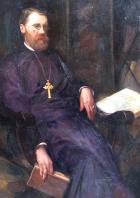and dated 1908 and further inscribed on the reverse "Edward Talbot Bishop Southwark / Harris Brown / pinx 1908"
Talbot, Edward Stuart (1844–1934), bishop of Winchester, the younger son of John Chetwynd Talbot QC (1806–1852), fourth son of the second Earl Talbot and a leader of the parliamentary bar, and his wife, Caroline Jane (d. 1876), only daughter of James Archibald Stuart-Wortley, first Baron Wharncliffe, was born at 10 Great George Street, London, on 19 February 1844. His father, who was a strong supporter of the Oxford Movement, died in 1852, and his widowed mother formed a close friendship with the two sisters Lady Lyttelton and Mrs Gladstone. Sent as a day boy in 1856 to Charterhouse, he was compelled by illness to leave in 1858. He went up to Christ Church, Oxford, in 1862, and obtained a first class inliterae humaniores (1865) and in law and modern history (1866), in which year he was elected a senior student of Christ Church, where he remained for four years as modern history tutor. In 1869 he was appointed first warden of Keble College, Oxford (H. P. Liddon, the first choice, having declined), and was ordained deacon. In 1870 he was ordained priest and married Lavinia [see Talbot, Lavinia (1849–1939)], third daughter of George William Lyttelton, fourth Baron Lyttelton; her eldest sister, Meriel, was the wife of his brother J. G. Talbot. They had three sons and two daughters: Edward Keble Talbot, who became superior of the Community of the Resurrection; Neville Stuart Talbot, bishop of Pretoria (1920–33) and subsequently vicar of St Mary's, Nottingham; Gilbert, killed in the Ypres salient in 1915; Mary, who married Lionel Ford, dean of York; and Lavinia.
In the autumn of 1870 Talbot went into residence at Keble. The university as a whole regarded the new foundation with contempt. To meet the situation no better warden than Talbot could have been found, and for eighteen years he presided successfully over the college. He aimed at giving it a sure foundation as a college in the university where men of limited means might lead a full common life under the influence of the Church of England. Frequent visits from W. E. Gladstone and his family gave prominence to the new college. Talbot was the college's first honorary fellow, elected in 1931.
A true son of the Oxford Movement, Talbot acknowledged the Tractarians as his spiritual fathers. He contributed to Lux mundi in 1889, but in contrast to that of Charles Gore his essay, ‘The preparation in history for Christ’, did not provoke controversy [see also Lux mundi essayists]. Like all the Lux mundi school, Talbot endeavoured to bring Tractarian principles into relation with the thought of the later nineteenth century and to forward the social concern of the church. It was mainly due to his initiative that Lady Margaret Hall was founded at Oxford in 1878 as a definitely Church of England college for women. He was one of the earliest supporters of the Oxford Mission to Calcutta, and a major influence in the founding of Oxford House in Bethnal Green.
In 1888 Talbot was appointed vicar of Leeds, where he remained for six years (1889–95). There he found himself in contact with hard-headed business men, working-class culture, and with many members of the free churches. Once when asked to which political party he belonged, he replied: ‘Conservative with a bad conscience’.
In 1890 Talbot declined the offer of the see of St Albans, but in 1895 was appointed bishop of Rochester. To the episcopate he brought academic distinction as well as educational and parochial experience. He completed the scheme inaugurated by his predecessors of dividing his unwieldy diocese, thus separating the more rural area round Rochester from the increasingly urbanized south London, where his bishop's house was located in Kennington. After protracted negotiations the work was accomplished, and Talbot was able to complete the other task which he had inherited, namely that of making the old church of St Saviour, Southwark, the cathedral of the new diocese. He was enthroned there in 1905. His relationship with his clergy was friendly, although breaches of prayer-book order by some of them placed him in a difficult position. The evangelical party suspected him as a Tractarian bishop, while high-churchmen resented his efforts to restore order. As time passed he was understood, and won the respect and love of all his clergy. By his own account he was not an original thinker, neither was he a ready speaker. At times he was hesitating, and in his anxiety to make his points clear could address his audience at too great a length. His son Neville characterized him as ‘not mystical and deficient on the other-worldly side’. He showed that a high-churchman could work with evangelicals and liberals, and could understand free churchmen also.
In 1911 Talbot was translated to the bishopric of Winchester, which he held for twelve years at the end of a full and busy life. His prestige stood high and he spoke with great authority in the councils of the church. One of Archbishop Davidson's staunchest supporters and a member of his small group of close confidants, he was noted for his width of view and his great gift of fairness. The last ten years of his life were spent in retirement in Kensington, where he died on 30 January 1934 at 45 Lexham Gardens. He is buried in the cathedral graveyard at Winchester. As The Times obituary notice rightly says, ‘he helped to create, as well as to maintain, a tradition essential both to religious and to national life’.
Sankey, rev. Geoffrey Rowell DNB
Henry Harris Brown was born in Northamptonshire 29 dec 1864. Studied in Paris under Bouguereau and Fleury. Settled in London 1891, where he enjoyed a successful practice. Exhibited RA (55), RHA (10). He also worked in the USA and Canada.



